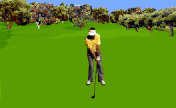By Jack Moorehouse
Concentrating on your mechanics while swinging usually leads to disaster. Thinking about how to hold your hands, make a good shoulder turn, or execute one of the other golf tips we pick up from magazines, newsletters, or golf lessons leads to topped shots, shanks, pushes, and other bad shots. More importantly, thinking about your mechanics causes you to ignore critical swing elements like rhythm and tempo, which contribute greatly to accuracy and consistency.
A great way to stop thinking about your mechanics while swinging is to build a swing you can trust—one that lets you focus on rhythm, tempo, and timing. How do you do this? You do it by ingraining key moves at critical swing points—like your set-up, downswing, and follow-through. Ingraining these moves enables you to forget about your mechanics and focus entirely on the task at hand. Improved focus leads to better shots. Better shots lead to better scores and better golf handicaps.
Let’s look at five key points where can ingrain moves that build trust in your swing:
Set-up
Setting up incorrectly generates swing faults that lead to bad shots. So you always want to set up correctly. For example, if you set up so that you’re reaching for the ball with your arms disconnected from your body, you’ll tend to take the club back to the outside. To build trust in your address position, set up your arm hang so that the club swings back automatically on plane. You can do this by bending from the waist so that when your arms hang down your triceps rest against your chest.
Takeaway
What you need to do with your takeaway, as I’ve said in hundreds of golf instruction sessions and golf tips, is start everything back in one piece. To help execute a one-piece takeaway correctly, try lightly brushing the grass behind that ball. When you keep the clubhead low to the ground like this, it makes it easy to stay on plane and create proper width in your swing. You may not actually hear the clubhead brush the grass during your takeaway, but keeping low helps builds trust in your takeaway and your swing.
Backswing
Your backswing is the source of many swing errors. If you could eliminate your backswing, you fee yourself of many swing errors. Obviously, you can’t eliminate your backswing. But you can build trust in it. To do that, you need to let the club swing freely to the top. You can do this by turning your back hip pocket behind you so that it feels like your clubhead and torso are moving back together. They should arrive at the top simultaneously.

At The Top
The top position is another key point where you want to build trust. But there’s some dispute as to where the toe of your club should be pointing when you reach the top. Some say it should be square or closed. Others say it should be pointing downward to provide the freedom to let the club go at the bottom. Most great golfers—the one’s that have lasted for years—pointed the club down and cupped their left wrist at the top. To build trust in your top position, do the same. It jump-starts a powerful release through the ball.
Impact
When you make good impact, you should feel like your back shoulder is on top of the ball. Too many weekend golfers ignore their back shoulders when swinging. To them the only thing that counts is their front shoulder. But ignoring your back shoulder produces pushes and hooks. To build trust at impact, swing the club so that it feels like the clubhead is passing through your hands at impact, not your hands trying to hold the face square at impact.
Building trust at these five key points in your swing builds trust in your entire swing. As a result, you won’t be thinking about the newest golf tips you’ve read or learned about in golf lessons during your swing. Instead, you’ll be focusing on more important things like rhythm, tempo, and timing—things that contribute greatly to better shots. Better shots lead to better scores and better scores lead to better golf handicaps. Trust me.
This entry was posted on Friday, August 20th, 2010 at 12:58 pm and is filed under Golf Articles. You can follow any responses to this entry through the RSS 2.0 feed. You can leave a response, or trackback from your own site.




No comments:
Post a Comment